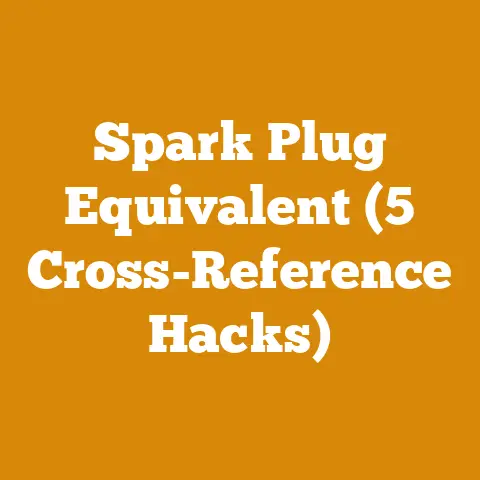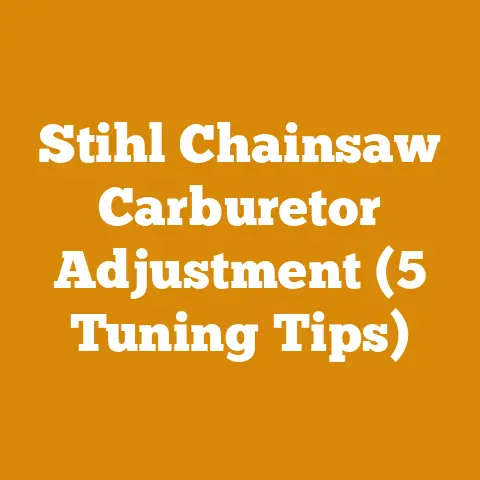How to Read Husqvarna Chainsaw Bar Numbers (4 Clues)
Before we get into the nitty-gritty details of reading Husqvarna chainsaw bar numbers, let’s chat about eco-friendly chainsaw options. With environmental concerns on the rise, many folks are looking for sustainable choices in chainsaws. Electric and battery-powered saws are taking the market by storm as they produce fewer emissions and are quieter than their gas counterparts. Husqvarna has been at the forefront of this movement, offering some stellar options for those considering a green switch. Have you ever tried one? They’re surprisingly powerful and make for a cleaner, more peaceful cutting experience!
Switching to an eco-friendly chainsaw doesn’t just benefit the environment; it can also be easier on your wallet in the long run. Reduced fuel costs, less maintenance, and no exhaust fumes are just a few perks. Plus, they’re perfect for residential areas where noise restrictions might be a concern. Imagine trimming your trees on a Sunday morning without waking up the entire neighborhood!
Now that we’ve covered some greener options, let’s dive into understanding those mysterious Husqvarna chainsaw bar numbers. Think of it as decoding a secret message with me as your guide!
4 Clues to Reading Husqvarna Chainsaw Bar Numbers
1. Length of the Bar
The first clue to deciphering those numbers is understanding the bar length. This is typically measured in inches and directly affects your saw’s cutting capacity. Whether you’re tackling thick logs or pruning branches, having the right bar length can make all the difference.
- How to Find It: Look for a number like “16” or “20” on the bar, which indicates the length in inches.
- Example: A “20” bar is great for larger tasks, while a “16” is more manageable for smaller jobs.
I remember one time I was out in the woods with a friend. We had to cut through a massive fallen tree blocking our path. Luckily, I had my trusty 20-inch bar ready to tackle the job. It sliced through like butter, saving us time and effort.
2. Pitch of the Chain
The pitch is all about the distance between links in your chain. It’s a critical factor in ensuring compatibility between the chain and sprocket. This detail might seem minor, but it plays a big role in your chainsaw’s performance.
- How to Find It: The pitch number is usually in millimeters, like “3/8” or “.325”.
- Story Time: I remember when I first learned about pitch. I thought I could just slap any old chain on my saw. Spoiler alert: it didn’t work. Learning about pitch saved me a lot of frustration!
Understanding pitch is essential when you’re purchasing replacement chains or parts. Mismatched pitch can lead to inefficient cutting and increased wear on your chainsaw.
3. Gauge of the Chain
The gauge refers to the thickness of the chain drive links. This affects how well the chain fits into the bar groove. A proper fit ensures smooth operation and reduces wear.
- How to Find It: Look for a decimal like “.050” or “.063”.
- Tip: Always double-check this number when buying a replacement chain. A mismatched gauge can lead to some serious headaches.
Once, I mistakenly bought a chain with the wrong gauge for my saw. It kept slipping off and even damaged the bar groove slightly before I realized my error. Lesson learned: always check twice!
4. Number of Drive Links
The number of drive links is essential for getting the correct chain length for your bar. It directly correlates with how well your chain will fit and function.
- How to Find It: You’ll see a number like “72” or “56” on the bar.
- Warning: Using the wrong number of drive links can damage your chainsaw, so make sure to count them carefully!
I once helped a buddy who was having trouble with his chainsaw not cutting properly. Turns out, he had too few drive links on his chain, causing poor tension and performance issues. After we fixed it, his saw worked like new.
My Personal Experience with Husqvarna Chainsaw Bars
Let me share a story about when I learned these lessons firsthand. I was trying to replace a chain on my trusty Husqvarna and didn’t pay attention to these numbers. After struggling for what felt like hours, I finally realized my mistake. It was a lightbulb moment, and now I always check those numbers first!
There was another time during a summer project when I was clearing some land for a small cabin build. I had multiple saws lined up, each with different bar lengths and specifications. Having the right setup made it so much easier to switch between tasks—whether it was felling trees or cutting firewood.
Equipment Requirements & Prerequisite Knowledge
Before you start dealing with chainsaw parts, here are some essentials you’ll need:
- Safety Gear: Goggles, gloves, helmet, and ear protection
- Basic Tools: Wrench, screwdriver, and file
- Knowledge: Understanding basic chainsaw maintenance and operation
Safety First! Never handle a chainsaw without proper safety gear. Trust me; it’s not worth the risk.
Knowing how to maintain your chainsaw is equally important. Regular cleaning, proper tensioning of the chain, and lubrication can extend your tool’s life significantly.
Step-by-Step: Reading Husqvarna Bar Numbers
- Locate the Numbers: Check near the base of the bar where it connects to the saw.
- Identify Length, Pitch, Gauge, and Links: Use the clues we’ve discussed.
- Cross-Reference with Chain: Ensure your chain matches these numbers precisely.
Taking these steps ensures that you have optimal performance every time you use your saw.
Detailed Steps:
Step 1: Locate the Numbers
Start by inspecting your chainsaw bar closely. The numbers are usually stamped into the metal near where the bar attaches to the saw body.
- Pro Tip: Sometimes these numbers can be faint due to wear or debris buildup. A quick clean with a cloth can help make them more visible.
Step 2: Identify Each Specification
With numbers in hand, break them down one by one: bar length first, followed by pitch, gauge, and finally drive links.
- Bar Length Example: If you see “18”, that’s an 18-inch bar.
- Pitch Example: A “3/8” marking indicates that each link is spaced three-eighths of an inch apart.
- Gauge Example: A “.050” marking tells you that this is the thickness of each drive link.
- Drive Links Example: Seeing “66” means there are 66 drive links on that chain.
Step 3: Cross-Reference with Chain
Before purchasing or installing a new chain, cross-reference all these numbers with what’s available at your local store or online retailer.
- Tip: Many stores offer cross-reference charts that help match chains to specific saw models based on these measurements.
Troubleshooting Tips
Even with all this knowledge at your fingertips, issues might arise from time to time:
- Chain Won’t Fit: Double-check all four numbers; mismatched specs are often culprits.
- Saw Vibrates Excessively: Ensure proper tension and lubrication; vibration can indicate misalignment or wear.
- Chain Slips Off: Reassess gauge and drive link numbers; incorrect sizing often causes slippage issues.
Important Reminders & Next Steps
Regular maintenance is key! Clean after each use and keep those chains sharp for optimal performance.
- Next Steps:
- Schedule regular maintenance checks.
- Keep an eye on wear patterns.
- Replace parts as needed rather than waiting for failures.
If ever unsure about compatibility or safety concerns arise during operation—consult professionals who can provide insights tailored specifically towards maintaining peak performance levels while ensuring user safety remains paramount throughout all processes involved therein.






